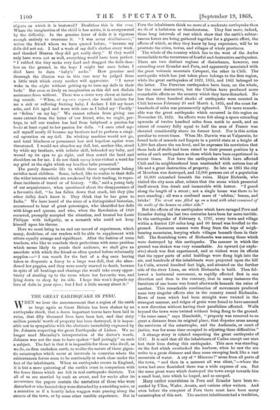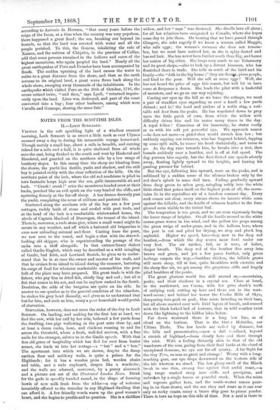THE GREAT EARTHQUAKE IN PERU.
AvHEN we hear the announcement that a region of the earth as large again as Great Britain has been shaken by an earthquake shock, that a dozen important towns have been laid in ruins, that fifty thousand lives have been lost, and that sixty million pounds' worth of property has been destroyed, it is impos- sible not to sympathize with the obstinate incredulity expressed by Dr. Johnson respecting the great Earthquake of Lisbon. We no longer need Macaulay's interpretation of the doctor's words. Johnson was not the man to have spoken "half jestingly" on such a subject. The fact is that it is impossible for those who dwell, as we do, on firm unshaken earth, to realize the nature of those gigan- tic catastrophes which occur at intervals in countries where the subterranean forces seem to be continually at work close under the feet of the inhabitants. When an earthquake occurs in England, it is but a mere quivering of the earth's crust in comparison with the fierce throes which are felt in real earthquake districts. Yet all of us are startled by such an event, and for weeks after its occurrence the papers contain the narratives of those who were disturbed or who fancied they were disturbed by a rumbling noise, or a sensation as if a heavily laden waggon were passing along the streets of the town, or by some other terrible experience. But in
Peru the inhabitants think no more of a moderate earthquake than we do of a hailstorm or thunderstorm. They fear more, indeed, those long intervals of rest which show that the earth's subter- ranean forces are being gathered together for a gigantic effort, the effects of which, as they they know by long experience, will be to prostrate the cities, towns, and villages of whole provinces.
The whole of the country which lies to the west of the Andes seems liable to the recurrence of fearful and destructive earthquakes. There are two distinct regions of disturbance, however, one extending over Ecuador and Peru, and apparently associated with the great volcanic mountain Cotopaxi, the other in Chili. The earthquake which has just taken place belongs to the first region, while the great earthquakes of 1822, 1835, and 1861 belonged to the latter. The Peruvian earthquakes have been, on the whole, far the most destructive, but the Chilian have produced more remarkable effects on the country which they have disturbed. No, less than three hundred shocks of earthquake were counted in Chili between February 20 and March 4, 1835, and the coast for hundreds of miles was permanently upheaved. Yet more remark- able was the great earthquake which occurred in this region on November 19, 1822. Its effects were felt along a space extending upwards of twelve hundred miles from north to south, and on extent of country fully equal to half the area of France was elevated considerably above its former level. Nor is this action peculiar to recent times. When Mr. Darwin was at Valparaiso, he found beds of mussels and limpets in a putrid state at a height of 1,300 feet above the sea level, and he expresses his conviction that these beds of shells had been raised to their present position by a. series of such earthquakes as those which have been experieneed in. recent times. Nor have the earthquakes which have affected Chili and its neighbourhood been unattended with serious loss of life and a great destruction of property. So late as 1861 the city of Mendoza was destroyed, and 12,000 persons out of a population of 16,000 entombed beneath the ruins. Major Richards, who visited the city soon after, relates that the scene which presented itself struck him dumb and immovable with horror. "I gazed; along the length of a street ; not a single house was there to be seen standing ; all was a confused mass of adobes,' beams, and bricks ! The street was filled up on a level with what remained of the walls of the houses on either side."
But the effects of the earthquakes which have ravaged Peru and Ecuador during the last two centuries have been far more terrible. In the earthquake of February 4, 1797, every town and village within a district 120 miles long and 60 broad was levelled to the ground. Enormous masses were flung from the tops of neigh- bouring mountains, burying whole villages beneath them in their fall. The flourishing town of Riobamba was among those which were destroyed by this earthquake. The manner in which the ground was shaken was very remarkable. An upward (or explo- sive) shock was first experienced, and so violent were its effects that the upper parts of solid buildings were flung high into the air, and hundreds of the inhabitants were projected upon the hill La Culls, several hundred feet high, and situated on the further- side of the river Lican, on which Riobamba is built. Then fol- lowed a horizontal movement, so rapidly effected first in one- direction and then in the contrary, that in many instances the furniture of one house was found afterwards beneath the ruins of another. This remarkable combination of movements produced some very singular effects also in the country round Riobamba. Rows of trees which had been straight were twisted in the strangest manner, and ridges of grain were found to have assumed a new direction without having their parallelism affected. Walls- beyond the town were twisted without being flung to the ground. "In some cases," says Humboldt, "property was removed to so great a distance from its original place, that disputes arose among the survivors of the catastrophe, and the Audiencia, or court of justice, was for some time occupied in adjusting these difficulties."
A strange story is related respecting the great earthquake of 1747. It is said that all the inhabitants of Callao except one man lost their lives during this earthquake. This man was standing on the fort which overlooked the harbour, when he saw the see retire to a great distance and then come sweeping back like a vast mountain of water. A cry of " Miserere I" arose from all parts a the town, "and then in a moment all was silent,"—where the town had once flourished there was a wide expanse of sea. Rut- the same great wave which destroyed the town swept towards him a small boat, into which he leaped, and so escaped.
Many earlier convulsions in Peru and Ecuador have been re- corded by Ulloa, Wafer, Acosta, and various other writers. And even before the conquest of Peru there must have been many catastrophes of this sort. The ancient inhabitants had a tradition, according to Antonio de Herrara, "that many years before the reign of the Incas, at a time when the country was very populous, there happened a great flood; the Sea, breaking out beyond its bounds, so that the land was covered with water and all the people perished. To this, the Guacas, inhabiting the vale of Nausea, and the natives of Chiquito, in the province of Callao, add that some persons remained in the hollows and caves of the highest mountains, who again peopled the land." Nearly all the great earthquakes of Peru and Ecuador have been accompanied by floods. The sudden upraising of the land causes the water to retire to a great distance from the shore, and then as the earth returns to its original level, a great wave flows back along the whole shore, sweeping away thousands of the inhabitants. In the earthquake which visited Peru on the 20th of October, 1746, the ocean retired twice, "and then," says Lyell, "returned impetu- ously upon the land. Lima was destroyed, and part of the coast converted into a bay ; four other harbours, among which were Cavalla and Guanapc, sharing the same fate."































 Previous page
Previous page